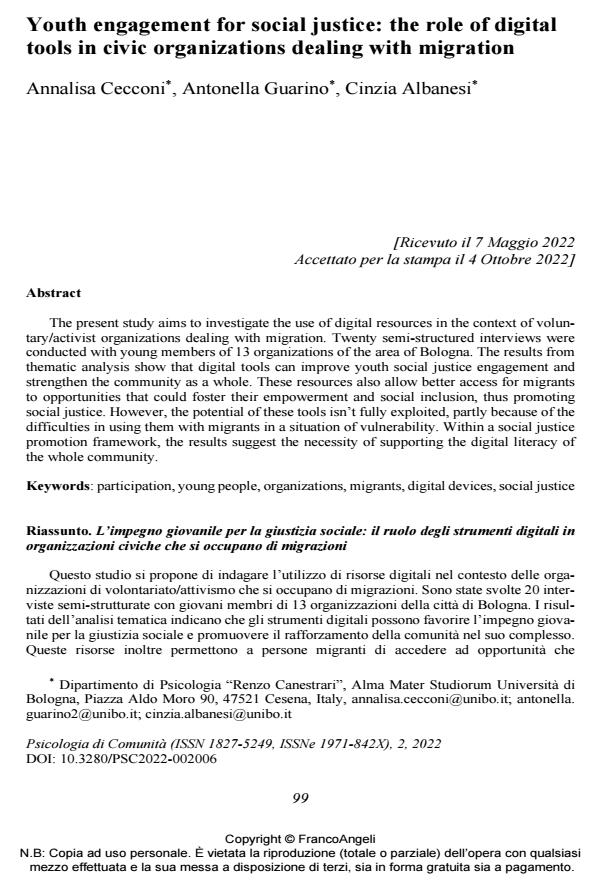Youth engagement for social justice: the role of digital tools in civic organizations dealing with migration
Titolo Rivista PSICOLOGIA DI COMUNITA’
Autori/Curatori Annalisa Cecconi, Antonella Guarino, Cinzia Albanesi
Anno di pubblicazione 2022 Fascicolo 2022/2
Lingua Inglese Numero pagine 20 P. 99-118 Dimensione file 230 KB
DOI 10.3280/PSC2022-002006
Il DOI è il codice a barre della proprietà intellettuale: per saperne di più
clicca qui
Qui sotto puoi vedere in anteprima la prima pagina di questo articolo.
Se questo articolo ti interessa, lo puoi acquistare (e scaricare in formato pdf) seguendo le facili indicazioni per acquistare il download credit. Acquista Download Credits per scaricare questo Articolo in formato PDF

FrancoAngeli è membro della Publishers International Linking Association, Inc (PILA)associazione indipendente e non profit per facilitare (attraverso i servizi tecnologici implementati da CrossRef.org) l’accesso degli studiosi ai contenuti digitali nelle pubblicazioni professionali e scientifiche
The present study aims to investigate the use of digital resources in the context of volun-tary/activist organizations dealing with migration. Twenty semi-structured interviews were conducted with young members of 13 organizations of the area of Bologna. The results from thematic analysis show that digital tools can improve youth social justice engagement and strengthen the community as a whole. These resources also allow better access for migrants to opportunities that could foster their empowerment and social inclusion, thus promoting social justice. However, the potential of these tools isn’t fully exploited, partly because of the difficulties in using them with migrants in a situation of vulnerability. Within a social justice pro-motion framework, the results suggest the necessity of supporting the digital literacy of the whole community.
Questo studio si propone di indagare l’utilizzo di risorse digitali nel contesto delle organiz-zazioni di volontariato/attivismo che si occupano di migrazioni. Sono state svolte 20 interviste semi-strutturate con giovani membri di 13 organizzazioni della città di Bologna. I risultati dell’analisi tematica indicano che gli strumenti digitali possono favorire l’impegno giovanile per la giustizia sociale e promuovere il rafforzamento della comunità nel suo complesso. Que-ste risorse inoltre permettono a persone migranti di accedere ad opportunità che potrebbero sostenerne l’empowerment e inclusione sociale, promuovendo così la giustizia sociale. Le po-tenzialità di tali risorse risultano tuttavia poco sfruttate, in parte a causa della difficoltà del loro utilizzo con migranti in situazione di vulnerabilità. In ottica di promozione della giustizia socia-le, i risultati suggeriscono la necessità di supportare l’alfabetizzazione digitale dell’intera co-munità, migrante e non.
Parole chiave:partecipazione, giovani, organizzazioni, migranti, digital devices, giustizia sociale
Annalisa Cecconi, Antonella Guarino, Cinzia Albanesi, Youth engagement for social justice: the role of digital tools in civic organizations dealing with migration in "PSICOLOGIA DI COMUNITA’" 2/2022, pp 99-118, DOI: 10.3280/PSC2022-002006